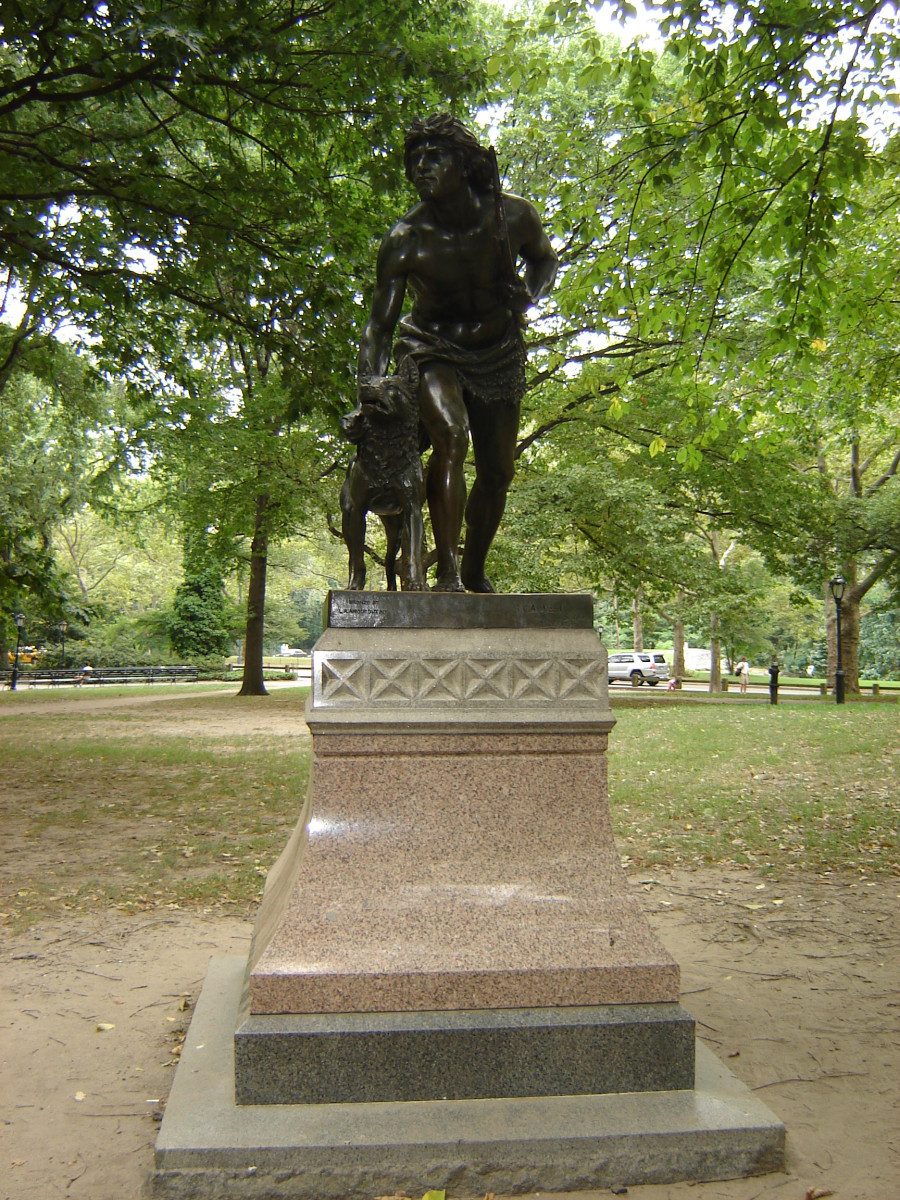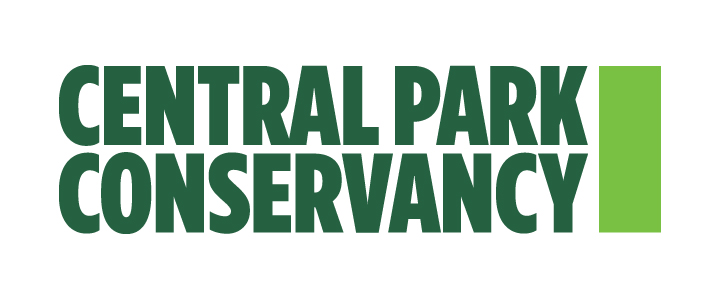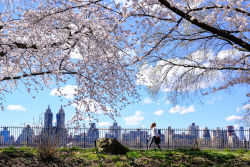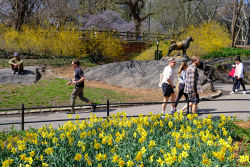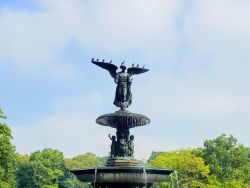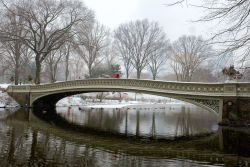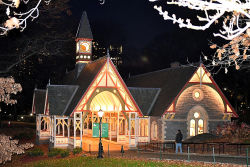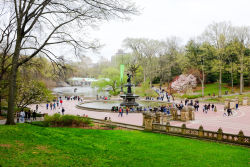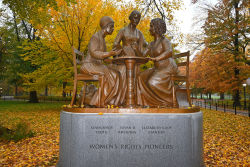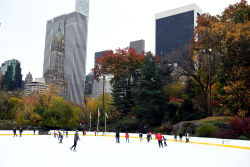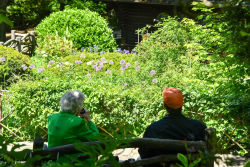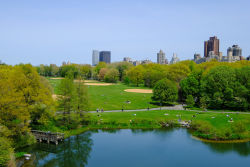Central Park
View all monuments in NYC Parks, as well as temporary public art installations on our NYC Public Art Map and Guide.
The Indian Hunter
| Artist: | John Quincy Adams Ward |
| Dedicated: | February 4. 1869 |
| Location: | South end of the Mall |
Artwork History
This striking bronze statue by John Quincy Adams Ward (1830–1910) demonstrates the technical mastery of an artist later dubbed “the dean of American sculptors.” It depicts a Native American hunter, bow in hand, restraining his snarling hunting dog. Cast in 1866 and dedicated on February 4, 1869, the statue was the first sculpture by an American artist to be placed in Central Park, and is one of the oldest works on outdoor display in the park.
The Indian Hunter derives from Ward’s artistic exploration of that theme beginning in the late 1850s; he displayed a smaller version of the subject at the Washington Art Association in 1859, and three years later, he exhibited a statuette of the Indian Hunter at the National Academy of Design. After the Civil War, Ward set about enlarging his conception to a full-size sculpture. In an effort to include naturalistic details, he traveled to the Dakotas, making sketches and three-dimensional models based on his direct observations of Native Americans.
Returning to New York, he crafted a full-scale, life-sized plaster model that was displayed in 1865 at Snedicor’s Gallery. Such was the romantic appreciation of Indian life, coupled with respect for Ward’s noble interpretation, that in 1866 a group of 23 prominent citizens - many of them Ward’s artistic peers - financed the $10,000 cost of casting the artwork. The acclaimed finished work was then displayed in 1867 at the Paris Exposition, and secured Ward’s prestige in the art world.
In 1868, the Committee of the Indian Hunter Fund presented the statue to the Board of Commissioners of Central Park, and commented, “It justly ranks among the best examples of the plastic art, for its bold and vigorous treatment, and its truthful delineation. We have the peculiar satisfaction in placing at your disposal a work so truly American in subject, and so admirably executed, by one of our native and most celebrated sculptors.” The commissioners concurred with this estimation, and selected a prominent placement southwest of the Mall.
Ward went on to a long and prolific career. He ultimately contributed nine sculptures to the parks of New York, among them Roscoe Conkling (1893) in Madison Square Park, Alexander Holley (1888) in Washington Square Park, William Earl Dodge (1885), now in Bryant Park, Horace Greeley (1890), now in City Hall Park, Henry Ward Beecher (1891) in Columbus Park, Brooklyn, and William Shakespeare (1872), The Pilgrim (1885), and the Seventh Regiment Memorial (1874) in Central Park.
Scholars have noted that the Indian Hunter may have been influenced by classical forerunners such as the famed Roman Borghese Warrior statue, with its forward leaning pose. In 1937, the Parks monuments crew replaced the vandalized bronze bow and in 1992, the Central Park Conservancy Monuments Program fully restored the statue. Returned to its former glory, this early work by Ward, with its fusion of realism and idealism, maintains its popularity with park goers.
Artwork Details
| Description: | Figure (over life-size) and dog on pedestal |
| Materials: | Bronze; Rockport granite (polished) |
| Dimensions: | H: 10' W: 5' D: 6'3" |
| Foundry: | L.A. Amouroux, N.Y. |
| Donor: | Subscription by artists and art patrons |
| Cast: | 1866 |
Please note, the NAME field includes a primary designation as well as alternate namingsoften in common or popular usage. The DEDICATED field refers to the most recent dedication, most often, butnot necessarily the original dedication date. If the monument did not have a formal dedication, the yearlisted reflects the date of installation.
For more information, please contact Art & Antiquities at (212) 360-8163.
Check out your park's Vital Signs
Clean & Safe
Green & Resilient
Empowered & Engaged Users
Share your feedback or learn more about how this park is part of a
Vital Park System
Contacts
Central Park Information: (212) 310-6600
Central Park Information (for the Hearing Impaired): (800) 281-5722
Belvedere Castle, The Henry Luce Nature Observatory: (212) 772-0210
The Charles A. Dana Discovery Center: (212) 860-1370
The Dairy Visitor Center and Gift Shop: (212) 794-6564
North Meadow Recreation Center: (212) 348-4867
Loeb Boathouse (Bike rentals, boat rentals & gondolas): (212) 517-2233
Carousel: (212) 879-0244
Fishing at Harlem Meer (Catch & Release): (212) 860-1370
Harlem Meer Performance Festival: (212) 860-1370
Horseback Riding - Claremont Stables: (212) 724-5100
Metropolitan Opera (Performances on the Great Lawn): (212) 362-6000
New York Philharmonic (Performances on the Great Lawn): (212) 875-5709
Shakespeare in the Park - The Public Theater at the Delacorte Theater: (212) 539-8655
Central Park SummerStage: (212) 360-2777
Swedish Cottage Marionette Theater: (212) 988-9093
Tennis: (212) 280-0205
Weddings, Ceremonies and Photography at the Conservatory Garden: (212) 360-2766
Wildlife Center & Tisch Children's Zoo: (212) 439-6500
